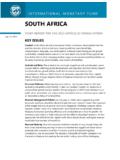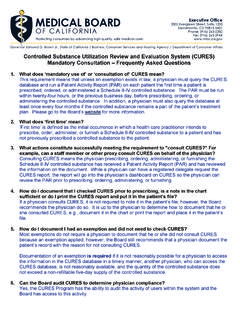Transcription of ˘ˇ ˆ - OECD.org
1 25*$1,6$7,21 )25 (&2120,& &2 23(5$7,21 $1' '(9(/230(17 .. 'LVFXVVLRQ 'UDIW RI WKH 5 HSRUW RQ WKH . $WWULEXWLRQ RI 3 URILWV WR D 3 HUPDQHQW . (VWDEOLVKPHQW .. 3 DUW ,9 ,QVXUDQFH .. &(175( )25 7$; 32/,&< $1' $'0,1,675$7,21 . Note to Business Commentators The Discussion Draft of Part IV (Insurance) of the Report on the Attribution of Profits to a Permanent Establishment is released for public comment for the first time. Comments should be submitted no later than 16 September 2005. Depending on the comments received a decision will be taken on whether it would be useful to have a face to face discussion with business commentators. Comments are particularly invited on the following issues: o The factual accuracy of the analysis of the most important functions of the modern insurance industry.))))))
2 O The impact of regulation, and in particular host country regulation, on the conduct of insurance business. o The commercial rational for internal reinsurance within a single enterprise. o The use of alternative risk transfer mechanisms, such as catastrophe bonds. o The types of risk which require surplus and how to determine the quantum of surplus and its location within a single enterprise. o Other issues as identified within the body of the Report. Commentators should be aware that the Working Party No. 6 is still processing the substantial business comments received on draft Part I. The final conclusions on Part I may impact upon the finalisation of Part IV. However, in view of the importance of receiving business input on the issues set out above that are specific to the insurance sector, it was decided to release Part IV.
3 Now, without waiting for the finalisation of Part I. 2. TABLE OF CONTENTS. 5. PART IV: DISCUSSION DRAFT OF THE REPORT ON THE ATTRIBUTION OF PROFITS TO A. PERMANENT ESTABLISHMENT - PART IV (INSURANCE) .. 7. A. 7. B. FACTUAL AND FUNCTIONAL ANALYSIS OF AN INSURANCE BUSINESS .. 8. B-1. General 8. i) Income and Capital (Surplus) in the Insurance 8. ii) Role of 10. B-2. Functions 11. (i) Functions of an insurance 11. a) Product management/Product development .. 11. b) Sales and 12. c) Underwriting Insured 13. d) Risk management/reinsurance .. 14. f) Contract and Claims 15. h) Asset 15. i) Support processes .. 16. B-4. Risks 17. i) Types of 17. (ii) Creditworthiness /Solvency margins .. 19. (iii) Surplus Requirements .. 20. iv) Other Regulatory Requirements.
4 20. v) Effect of 20. B-5. Agency 21. C. APPLICATION OF THE GUIDELINES TO INSURANCE COMPANIES. OPERATING THROUGH 22. D. APPLYING THE AUTHORISED OECD APPROACH TO INSURANCE. COMPANIES OPERATING THROUGH PEs .. 24. D-1. First Step: Determining the Activities and Conditions of the Hypothesised Distinct and Separate Enterprise .. 28. i) Attributing Functions, Assets and Risks to the PE .. 28. a) 28. b) Split Functions .. 31. c) Indirect Benefits Provided by Sales 32. d) Agency 32. ii) Attributing creditworthiness /solvency margin to the PE .. 34. iii) Attributing Investment Income/Assets and Surplus to the 35. a) General 35. b) Capital allocation approach .. 37. c) Thin capitalisation 40. d) Safe harbour - Quasi-thin capitalisation/regulatory minimum 41.
5 3. e) Conclusion on attributing surplus to the PE .. 42. f) Determining the investment yield from surplus attributed to a 43. D-2. Second Step: Determining the Profits of the Hypothetical Distinct and Separate Enterprise( Based on a Comparability Analysis).. 44. i) Identifying Dealings .. 44. ii) Recognition of dealings .. 45. iii) Internal Reinsurance .. 46. iv) Applying Transfer Pricing Methods to Attribute 48. v) Rewarding specific insurance functions .. 50. a) 50. b) Risk management and reinsurance .. 50. c) Asset management .. 51. d) Product development .. 51. e) Sales and Marketing .. 52. f) Support 53. E ARTICLE 7(4) IS IT 55. F. ARTICLE 7(7) COORDINATION WITH ARTICLE 10(4) ETC .. 56. 4. PREFACE. 1. The permanent establishment (PE) concept has a history as long as the history of double taxation conventions.
6 Currently, the international tax principles for attributing profits to a PE are provided in Article 7 of the OECD Model Tax Convention on Income and on Capital, which forms the basis of the extensive network of bilateral income tax treaties between OECD Member countries and between many OECD Member and non-member countries. 2. There is considerable variation in the domestic laws of OECD Member countries regarding the taxation of PEs. In addition, there is no consensus amongst the OECD Member countries as to the correct interpretation of Article 7. This lack of a common interpretation and consistent application of Article 7 can lead to double, or less than single, taxation. The development of global trading of financial products and electronic commerce has helped to focus attention on the need to establish a broad consensus regarding the interpretation and practical application of Article 7.
7 3. As a first step in establishing a broad consensus, a Working Hypothesis (WH) was developed as to the preferred approach for attributing profits to a PE under Article 7. This approach built upon developments since the last revision of the Model Commentary on Article 7 in March 19941, especially the fundamental review of the arm's length principle, the results of which were reflected in the 1995 OECD. Transfer Pricing Guidelines (the Guidelines). The Guidelines address the application of the arm's length principle to transactions between associated enterprises under Article 9. The basis for the development of the WH was to examine how far the approach of treating a PE as a hypothetical distinct and separate enterprise could be taken and how the guidance in the Guidelines could be applied, by analogy, to attribute profits to a PE in accordance with the arm's length principle of Article 7.
8 The development of the WH was not constrained by either the original intent or by the historical practice and interpretation of Article 7. Rather the intention was to formulate the preferred approach to attributing profits to a PE under Article 7. given modern-day multinational operations and trade. 4. To meet the policy goals described above, the WH was tested by considering how it could be applied in practice to attribute profits both to PEs in general and, in particular, to PEs of businesses operating in the financial sector, where trading through a PE is widespread. A Discussion Draft containing the interim results of testing the application of the WH to PEs in general (Part I) and to PEs of banking enterprises (Part II) was released for public comment in February 2001.
9 Twenty five responses were received from the business community, banking associations and advisory firms, reflecting a diversity of views and interests. Because of the variety of positions expressed and the complexity of the issues, a consultation was held in Paris in April 2002 with the commentators on the Discussion Draft. The consultation was very valuable as it allowed the identification of common ground in terms of principles, of areas that needed further clarification and of areas where further work was needed. 5. A revised Part II and a Part III (Global Trading) were released for public comment on 4 March 2003. Nineteen responses were received from the business community, banking associations and advisory 1. This revision followed the publication of Issues in International Taxation No.
10 5: Model Tax Convention: Attribution of Income to Permanent Establishments". 5. firms. Again because of the complexity of the issues, a second consultation was held in Geneva in March 2004 and a meeting with selected commentators held in Paris in October 2004. It is expected that Parts II. and III will be finalised in 2005. A Revision of Part I was released in August 2004, which takes account of the comments received and the discussions during both consultations. 6. The testing of the WH is reaching its conclusion and sufficient progress has been made in the development of the WH to mean that the WH has now become the authorised OECD approach. This draft (Part IV) completes the testing process by describing how the OECD authorised approach would apply to attribute profits to a PE carrying on insurance business.















